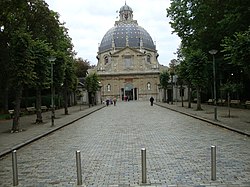Scherpenheuvel-Zichem
| Scherpenheuvel-Zichem | |||
|---|---|---|---|
| Municipality | |||

Scherpenheuvel basilica
|
|||
|
|||
| Location in Belgium | |||
| Coordinates: 51°00′N 04°58′E / 51.000°N 4.967°ECoordinates: 51°00′N 04°58′E / 51.000°N 4.967°E | |||
| Country | Belgium | ||
| Community | Flemish Community | ||
| Region | Flemish Region | ||
| Province | Flemish Brabant | ||
| Arrondissement | Leuven | ||
| Government | |||
| • Mayor | Manu Claes (CD&V-N-VA) | ||
| • Governing party/ies | CD&V-N-VA, VLD | ||
| Area | |||
| • Total | 50.50 km2 (19.50 sq mi) | ||
| Population (1 January 2016) | |||
| • Total | 22,833 | ||
| • Density | 450/km2 (1,200/sq mi) | ||
| Postal codes | 3270-3272 | ||
| Area codes | 013, 016 | ||
| Website | www.scherpenheuvel-zichem.be | ||
Scherpenheuvel-Zichem (Dutch pronunciation: [ˌsxɛrpə(n)ɦøːvəl ˈzɪxɛm]) is a municipality located in the province of Flemish Brabant, Flemish Region, Belgium, encompassing the towns of Averbode, Messelbroek, Okselaar, Scherpenheuvel, Schoonderbuken, Keiberg, Kaggevinne, Testelt and Zichem (previously spelled Sichem, like the biblical town). On January 1, 2006, Scherpenheuvel-Zichem had a total population of 22,064. The total area is 50.50 km² which gives a population density of 437 inhabitants per km².
Scherpenheuvel (English: "sharp Hill"), the most important pilgrimage (Roman Catholic) site in Belgium, is located some 50 km east of Brussels. Its origins date back to the pagan worship that still survived during the Middle-Ages around a holy oak on this hilltop. The cross-shaped tree was thus "Christianized" with a statue of the Holy Mary.
Legend has it that around AD 1500 the Virgin Mary performed a miracle here, freezing into place a shepherd boy who tried to take home the small statue, thus foiling the theft. As of the 1550s, a flood of devoted pilgrims, arriving from surrounding areas, came to the tree to pray for the health and recovery of their ill loved ones. In 1580, the statue disappeared as Dutch-Protestant iconoclasts pillaged the region. Seven years later it was replaced by a new one, which still stands on the altar of the present-day pilgrimage-church. The oak tree being almost dead but still inspiring in fetishist worship alongside the Roman Catholic devotion to Mary was felled by order of the Bishop of Antwerp. A first wooden chapel was built on the site and a number of statues of the Holy Virgin cut out of the trunk found their way to various sanctuaries (such as Luxembourg). The fame of Scherpenheuvel increased and increasing numbers of people arrived, begging for protection against plague and famine that swept the Low Countries as a consequence of the "Eighty Years War" (Dutch Revolt). The chapel soon became far too small for them.
...
Wikipedia




